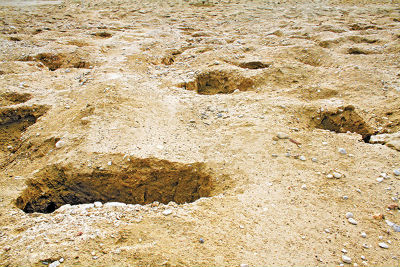Archaeological Looting and the Destruction of Cultural Heritage
Can we prevent archaeological looting?
By Robin Ngo | June 10, 2019 | Biblical Archaeological Society
 The aftermath of archaeological looting is often visible in the landscape in the form of lunar-like craters. Seen here are craters at an ancient cemetery site southeast of the Dead Sea in Jordan. Photo: Hershel Shanks
The aftermath of archaeological looting is often visible in the landscape in the form of lunar-like craters. Seen here are craters at an ancient cemetery site southeast of the Dead Sea in Jordan. Photo: Hershel ShanksArchaeological looting is a global issue that threatens the preservation of our shared cultural heritage. In the Middle East, archaeological looting and the deliberate destruction of archaeological sites and monuments amid ongoing warfare have captured international attention. Antiquities looted from sites in Syria and northern Iraq and subsequently trafficked are one of the main sources of funding for the Islamic State, the Sunni extremist group referred to as ISIS or ISIL. What, if anything, can be done to protect these objects and sites?
In “Is It Possible to Protect Our Cultural Heritage?” in the March/April 2015 issue of Biblical Archaeology Review, BAR editor Hershel Shanks examines local and international efforts to address the archaeological looting and devastation of sites in the Middle East. In Shanks’s view, these efforts, while laudable, have thus far been ineffective in protecting cultural property.
Continuous conflict has left thousands of archaeological sites in Syria and Iraq – including those of the Bronze, Iron, Greek, Roman, Byzantine and Islamic periods – vulnerable. The culturally diverse ancient city of Dura-Europos, where one of the earliest Christian house-churches was discovered, has been heavily pillaged over the past few years. In July 2014, ISIS militants blew up the mosque that housed the traditional tomb of the prophet Jonah in Mosul, Iraq. According to a report from September 2014, five of the six World Heritage sites in Syria “exhibit significant damage” due to ongoing warfare.
Cultural heritage experts believe that ISIS militants have been responsible for much of the archaeological looting going on in Syria and northern Iraq since the rise of the rebel group. Criminal networks seeking to profit from the turmoil, however, are also to blame. The Art Newspaper reports that there has been a 133% rise in Syrian objects imported into the United States.
How effective would the placement of guards be for on-the-ground protection of vulnerable archaeological sites in this region? A story recounted in the New York Times offers a glimpse of the danger of such a situation: Maamoun Abdulkarim, director general of antiquities and museums in Damascus, relayed the tragic fate of a ranger who guarded several sites in the eastern Syrian city of Deir al-Zour – he was beheaded.
There are myriad efforts by professionals, government organizations and concerned citizens to address the loss of cultural heritage in conflict areas. The Safeguarding the Heritage of Syria Initiative is building a database to document the destruction of Syrian sites and artifacts – thus preserving at least the memory of cultural treasures. The Combatant Command Cultural Heritage Action Group trains U.S. military personnel to protect cultural property during operations. The International Council of Museums published the Emergency Red List of Syrian Cultural Objects at Risk to make art and heritage professionals and law enforcement officials aware of looted Syrian antiquities that may resurface in the art market.
In his BAR article, Shanks remarks, “While we should applaud those who are devoting themselves to protecting cultural property, there seems to be no effective means to prevent the destruction amid the turmoil gripping the Middle East. Much of the professional effort is devoted to documenting the destruction, rather than preventing it.”
In the face of this bleak – but frank – sentiment, it is nevertheless commendable that greater awareness is being raised for the value of our shared cultural heritage. Greater awareness can inspire more vigilance and better ideas for the protection of cultural property.
Speaking at the “Heritage in Peril: Iraq and Syria” event at the Metropolitan Museum of Art in New York on September 22, 2014, U.S. Secretary of State John Kerry said, “The fight to protect the cultural heritage of Iraq and Syria isn’t just about shared values. It’s about protecting a shared legacy […] ISIS forces the people of Iraq and Syria to pay for their cultural heritage in blood. We are determined instead to help Iraqis and Syrians protect and preserve their heritage in peace. That’s our common responsibility.”
Learn more about the archaeological looting of sites in the Middle East by reading the full article “Is It Possible to Protect Our Cultural Heritage?” by Hershel Shanks in the March/April 2015 issue of BAR.
(This article was originally published in 2015. Click here to view complete article.)
